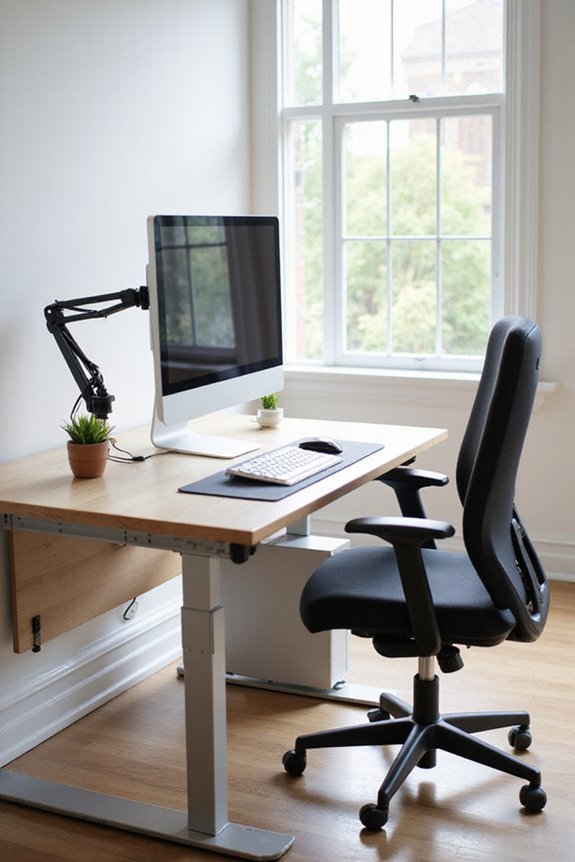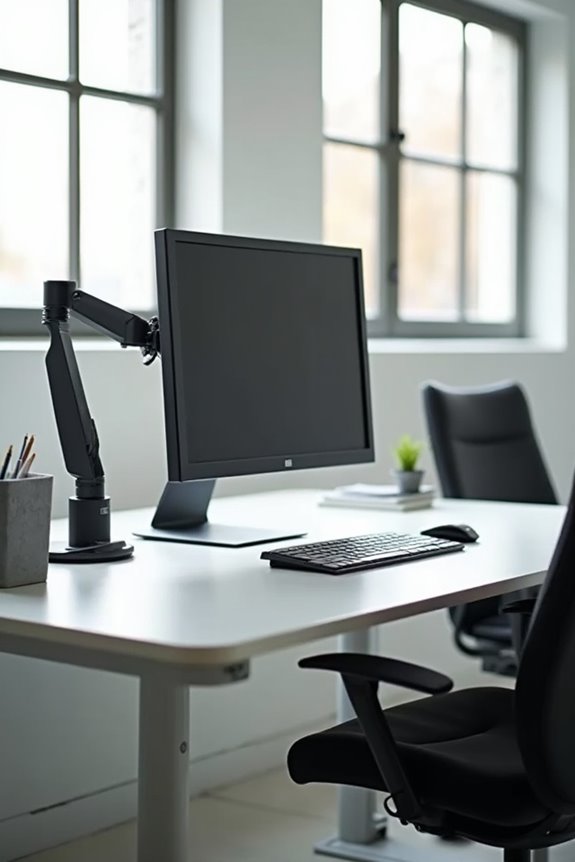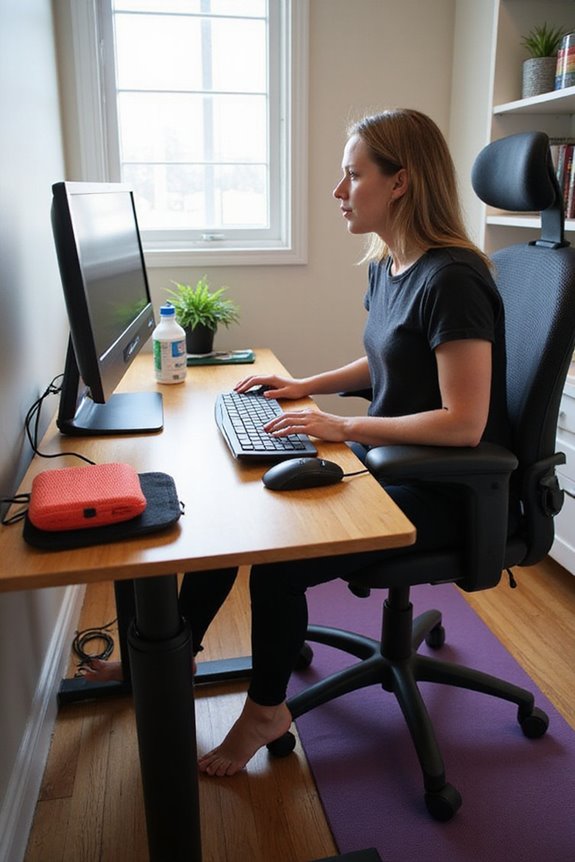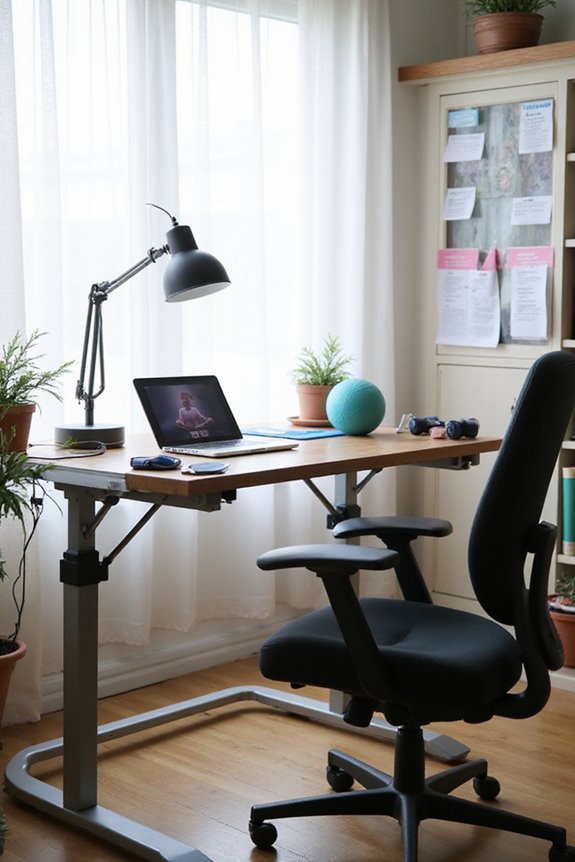Ergonomic equipment effectively reduces office-related pain through several key components:
- Chairs combat back and neck pain by promoting proper posture.
- Sit-stand desks lead to a 54% decrease in upper back discomfort and enhance productivity by 23%.
- Keyboards and mice maintain neutral hand positions, yielding over 80% user satisfaction.
- Monitor positioning is essential, with ideal height and distance reducing eye strain.
Exploring various ergonomic solutions can further enhance workplace comfort and efficiency.
Key Takeaways
- Ergonomic chairs provide spine support, alleviating back and neck pain while promoting proper posture alignment.
- Sit-stand desks significantly reduce upper back and neck pain by 54% and lower back discomfort by over 50%.
- Proper monitor positioning, with the top at eye level and 20 to 40 inches away, minimizes eye strain and neck twisting.
- Ergonomic keyboards and mice support neutral wrist positions, reducing strain and enhancing user satisfaction.
- Workspace accessories and clutter management foster comfort, emotional well-being, and overall job satisfaction.
Ergonomic Chairs for Back and Neck Relief
Ergonomic chairs play an essential role in alleviating back and neck pain among office workers. Designed to support the natural curvature of the spine, these chairs integrate essential features like lumbar support and targeted neck support, which help in reducing strain.
Key Features:
- Adjustable Components: Customizable seat height and lumbar support enhance individual comfort.
- Proper Posture: Encouraged alignment mitigates chronic back and neck pain, promoting musculoskeletal health.
- Dynamic Support: Active sitting features maintain muscle engagement, further reducing discomfort.
Research indicates that users experience significant pain relief after shifting to ergonomic chairs, making them a crucial investment for a healthier workplace. By prioritizing neck and lumbar support, organizations can foster a more productive and comfortable work environment.
Benefits of Sit-Stand Desks

Sit-stand desks offer a range of benefits that can greatly improve workplace health and productivity.
Health Benefits
- Users report a 54% reduction in upper back and neck pain.
- Lower back discomfort decreases from 80% to over 50% among sit-stand desk users.
- Associated with small decreases in blood pressure, promoting cardiovascular health.
Productivity Boost
- Initial productivity increases of 23%, potentially reaching 53% after six months.
- Standing desk users produce up to 45% more output in call center environments.
- Improved mental focus noted by 71% of employees reducing sitting time by one hour daily.
Optimal Monitor Positioning

Proper monitor positioning is essential for maintaining comfort and preventing physical strain in the workplace.
Monitor Height
- The top of the monitor should be at or slightly below eye level to minimize neck and shoulder strain.
- For users with bifocals, positioning the monitor lower is advisable to reduce head tilt.
Viewing Distance
- The monitor should be placed approximately 20 to 40 inches away, or about an arm’s length, to reduce eye strain.
- Larger monitors may necessitate increased viewing distances for ideal comfort.
- Maintaining this distance allows the eyes to focus with less effort, decreasing fatigue.
Additional Considerations
- The monitor should be centered directly in front of the user to avoid unnecessary neck twisting.
- A slight downward tilt of about 15 degrees aids in maintaining natural posture.
Ergonomic Keyboards and Mice

When considering office equipment, the design of keyboards and mice plays an essential role in promoting employee health and productivity.
Ergonomic Keyboards
- Designed to maintain wrists and arms in a neutral position, reducing strain and discomfort.
- Compact and split designs encourage natural hand positioning.
- Adjustable elevation minimizes pressure points, while low-force keys lower muscle fatigue.
- Reduce carpal tunnel syndrome incidence by approximately 30%.
Ergonomic Mice
- Vertical designs promote a handshake position, decreasing wrist and shoulder pain.
- Allow for longer work sessions without discomfort.
- Complement ergonomic keyboards to enhance overall upper limb comfort.
High user satisfaction rates (over 80%) are reported by individuals who switch to ergonomic inputs, greatly boosting productivity by up to 10%.
Importance of Ergonomic Training

How can ergonomic training greatly enhance workplace safety and productivity?
Ergonomic training is essential for fostering ergonomic awareness among employees, which directly contributes to injury prevention. By educating workers on proper posture and equipment use, organizations can reduce musculoskeletal disorders (MSDs) by an average of 61%.
Key benefits include:
- A 25% increase in productivity due to improved comfort and efficiency.
- A reduction in lost workdays by up to 88% from fewer MSD-related absences.
- Enhanced employee morale and lower turnover rates, decreasing by nearly 40%.
Effective ergonomic training aligns with OSHA’s recommendations, embedding a culture of safety within the workplace. Ultimately, this proactive approach not only safeguards employee health but also enhances overall organizational performance.
Accessories for Enhanced Comfort
Accessories designed for enhanced comfort play a crucial role in maintaining a productive and health-conscious workspace. These ergonomic tools provide essential support and customization options tailored to individual needs.
- Proper Alignment: Accessories guarantee the correct positioning of the spine, shoulders, and neck, minimizing strain.
- Encourages Movement: They promote gentle movement, preventing stiffness and enhancing circulation.
- Cost-Effective: Many ergonomic accessories offer significant value without excessive cost.
These elements contribute to productivity enhancement, as a comfortable workspace correlates with improved performance. Key accessories include adjustable chairs, lumbar support devices, and ergonomic keyboards, which collectively facilitate an ideal working environment. Ultimately, prioritizing comfort through these accessories can lead to a more focused and efficient work experience.
Managing Workspace Clutter
Managing workspace clutter is essential for optimizing productivity and maintaining a healthy work environment. Effective clutter management and workspace organization can greatly enhance focus and efficiency.
- Research indicates that individuals lose approximately 2.5 days annually searching for misplaced items, highlighting the economic impact of disorganization.
- Clutter increases cognitive overload, leading to distractions and reduced creative thinking, which can elevate stress levels.
- A tidy workspace fosters better emotional well-being, reducing anxiety and contributing to greater job satisfaction.
Moreover, a clutter-free environment minimizes physical risks, such as tripping hazards, ensuring a safer workspace. Ultimately, organizations benefit from implementing systematic clutter control measures, which align with goals for enhanced employee productivity and retention, resulting in measurable operational cost savings.
The Role of Anti-Fatigue Mats
Anti-fatigue mats play an essential role in enhancing workplace comfort and productivity, particularly in environments where employees are required to stand for extended periods. The anti-fatigue benefits include increased blood circulation, reduced musculoskeletal pain, and decreased physical stress on the body.
Mat selection is vital; appropriate thickness, cushion, and durable materials are necessary for ideal support. Mats should encourage subtle foot movement to promote circulation, while size and placement must prevent tripping hazards.
Utilizing anti-fatigue mats can lead to a 22% increase in worker productivity, equating to roughly 45 additional workdays annually. Additionally, they mitigate ergonomic hazards, supporting overall worker health and reducing absenteeism associated with standing-related discomfort.
Frequently Asked Questions
How Often Should I Take Breaks When Using Ergonomic Equipment?
Break frequency should ideally be every 30 minutes, with preferable intervals including microbreaks of 1-2 minutes. This approach promotes overall well-being, encouraging individuals to integrate movement and rest into their work routine for enhanced comfort.
Can Ergonomic Adjustments Improve Productivity in the Workplace?
The question of whether ergonomic adjustments improve productivity in the workplace has garnered attention. Research indicates that ergonomic benefits can lead to significant productivity increases, fostering a more engaged and cohesive work environment for employees.
What Signs Indicate I Need Ergonomic Equipment?
When one feels the weight of discomfort on their shoulders, pain symptoms like stiffness or fatigue signal a need for equipment evaluation. Recognizing these signs fosters a healthier workspace, enhancing well-being and belonging in the office community.
Are There Specific Exercises to Complement Ergonomic Setups?
To complement ergonomic setups, incorporating stretching routines and posture exercises greatly enhances comfort. These practices foster a supportive environment, encouraging individuals to connect while prioritizing well-being and productivity, ultimately promoting a healthier workplace culture for everyone.
How Do I Choose the Right Ergonomic Accessories for My Needs?
Research indicates that 80% of office workers experience discomfort. To select ergonomic accessories, individuals should assess personal preferences and workspace layout, ensuring a harmonious setup that enhances comfort, productivity, and overall well-being in their environment.




